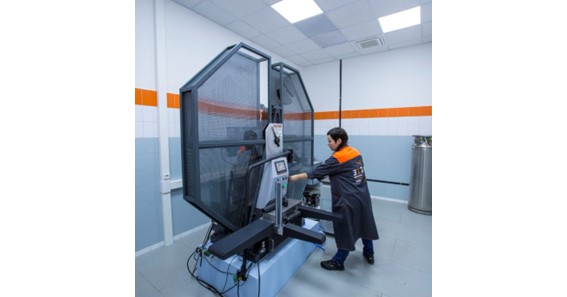Material testing refers to the process through which different materials are analyzed under different conditions to assess their properties, strength, and durability. This analysis is vital in industries like construction, aerospace, and manufacturing. It is used to verify that the materials used can withstand specific stresses and perform as required in their intended applications.
There are many types of material testing, and impact testing is certainly one of the most common. There are many types of this test, but drop weight testing and pendulum impact testing are the most commonly used. What are these methods, what are their purposes, and most importantly, how are they different?
We will compare these two methods of material testing under the umbrella of impact testing. However, before we compare these methods, let’s take a closer look at how they are conducted and why they are used.
Drop Weight Testing
Let’s begin by exploring drop weight testing. In impact testing, this approach is used to determine a material’s resistance to sudden external forces. This is particularly relevant to materials that may be subject to dynamic stresses during their service life. The test is conducted using specially designed drop weight testing equipment.
1. Overview of Drop Weight Testing
- Drop weight testing involves dropping a weight from a specified height onto a test specimen to determine its impact resistance.
- Material toughness and durability are tested using this method.
2. Key Components and Test Procedure
- There are three essential components: a weight (dropped object), a device to release the weight from a controlled height, and a sample holder.
- During the test, the weight is lifted to a predetermined height and then released to impact the specimen. The height from which the weight is dropped varies depending on the material and the test requirements.
3. Data and Information Obtained
- It measures the amount of energy absorbed by the specimen during impact, which is often expressed in terms of toughness or impact strength.
- A failure’s nature, such as whether the material shatters, deforms, or cracks, may be included as additional information.
4. Advantages and Limitations
- Its simplicity and ability to simulate real-world impact conditions are some of the advantages of drop weight testing.
- Its limitations may include less precision than other impact testing methods, as well as a limited scope of application, mainly suitable for materials that are expected to withstand high impacts.
5. Applications and Materials Tested
- It is commonly used for materials such as plastics, composites, and ceramics, especially in industries such as automotive, construction, and pipeline manufacturing.
- Standards such as ASTM D2444 and ISO 3127 govern testing procedures, guaranteeing consistency, especially for thermoplastic pipes.
Pendulum Impact Testing
Under impact loading, pendulum impact testing determines the impact strength or toughness of materials, particularly metals. Research and development as well as quality control and material acceptance depend on this test. Specially designed pendulum impact testing equipment is used for the test.
1. Overview of Pendulum Impact Testing
- During an impact, this method uses a pendulum to measure the energy absorbed by a material. The amount of plastic or permanent deformation that a material can tolerate before failure depends on this information.
- Tests typically involve striking a metal sample with a pendulum hammer from a specific height and measuring the amount of energy absorbed.
2. Key Components and Test Procedure
- A pendulum hammer, sample holder, and energy measurement system are key components.
- During the test, the pendulum is released from a predetermined height to strike the sample. Based on the pendulum swing, the amount of energy absorbed is calculated after striking.
3. Data and Information Obtained
- Data obtained include the amount of energy absorbed by the sample, which indicates the toughness of the material.
- Materials’ results can be used to predict their performance under real-world conditions, especially in critical applications.
4. Advantages and Limitations
- In addition to measuring energy absorption accurately, the method is suitable for a wide range of materials, including metals.
- There may be limitations due to the complexity of the setup and the need to prepare specific samples.
5. Applications and Materials Tested
- It is widely used in the automotive and aerospace industries to select materials for components like bumpers, chassis, and structural elements.
- The testing procedures comply with standards such as ISO 148-1, ISO 14556, and ASTM E23.
Comparing Drop Weight and Pendulum Impact Testing
Pendulum impact testing and drop weight testing have several key differences that make them suitable for different types of testing.
Differences in Methodology and Application
- Tests of drop weights measure a material’s resistance to sudden forces, simulating real-world impacts. Materials such as plastics and composites are often tested using this method.
- In contrast, pendulum impact tests measure the energy absorbed by materials, particularly metals. The test is ideal for evaluating the toughness and durability of materials under impact loads. Automobile and aerospace industries extensively use this method to evaluate materials’ performance under varying impact forces.
Advantages and Suitability
- The simplicity of drop weight testing makes it ideal for a wide range of applications, especially in initial material screening. Its less precise nature may limit its suitability for applications requiring detailed analysis of material behavior under impact.
- Impact pendulum testing provides higher precision and is essential to understanding a material’s performance in real-world conditions. Due to its complexity and the need for specific sample preparations, it may require specialized equipment and expertise.
Selecting the Right Method
- Choosing between these two methods depends on the material being tested and the industry standards that need to be met. For a quick evaluation of material toughness and durability, drop weight testing is more suitable than pendulum impact testing.
- Also, industries such as aerospace and automotive, where material failure can result in serious consequences, prefer pendulum impact testing for its detailed insights.
For high-stakes applications, pendulum impact testing provides a more detailed and precise analysis of material toughness, which is crucial compared to drop weight testing. Choosing between these methods should take into account specific material properties, industry standards, and the criticality of the application.






